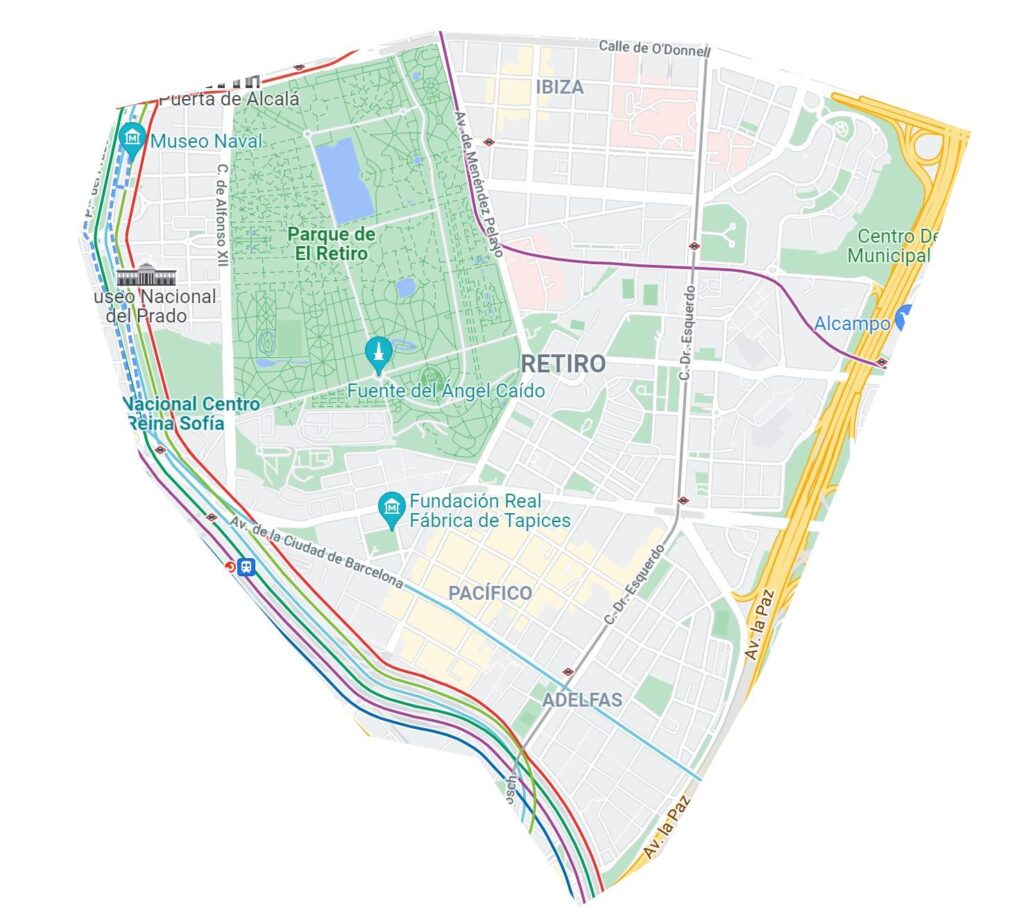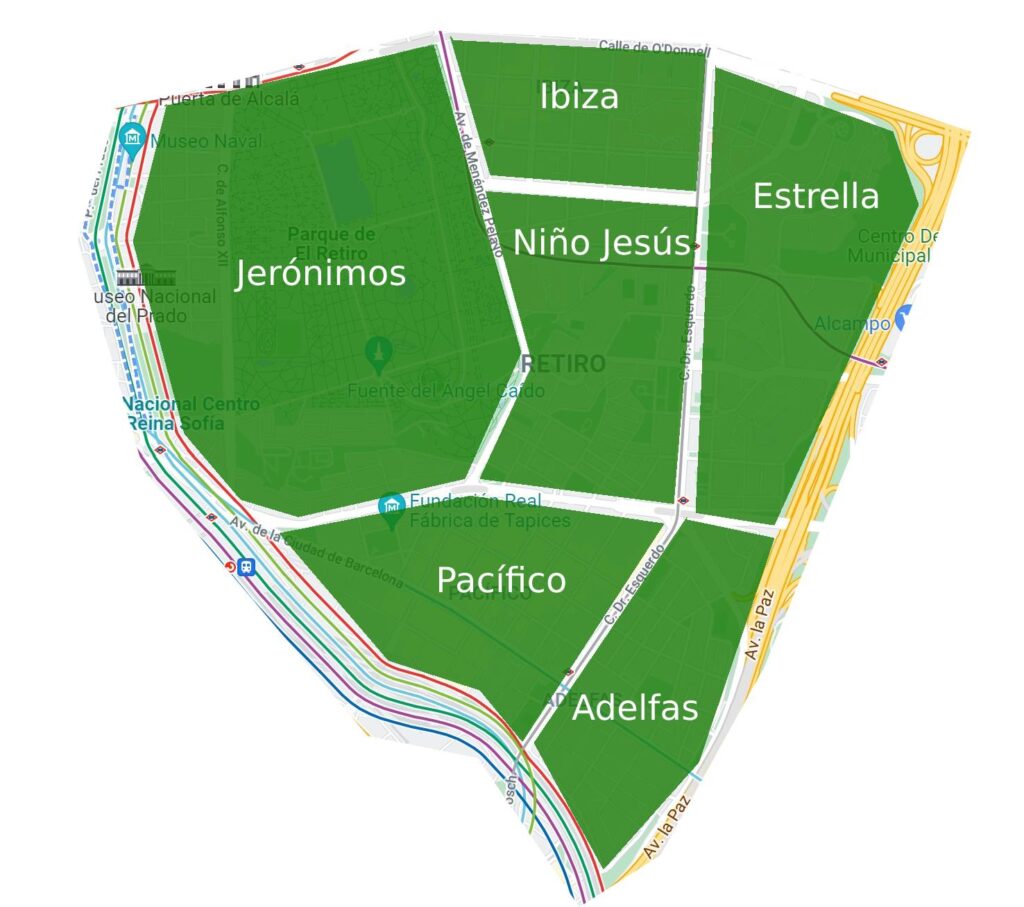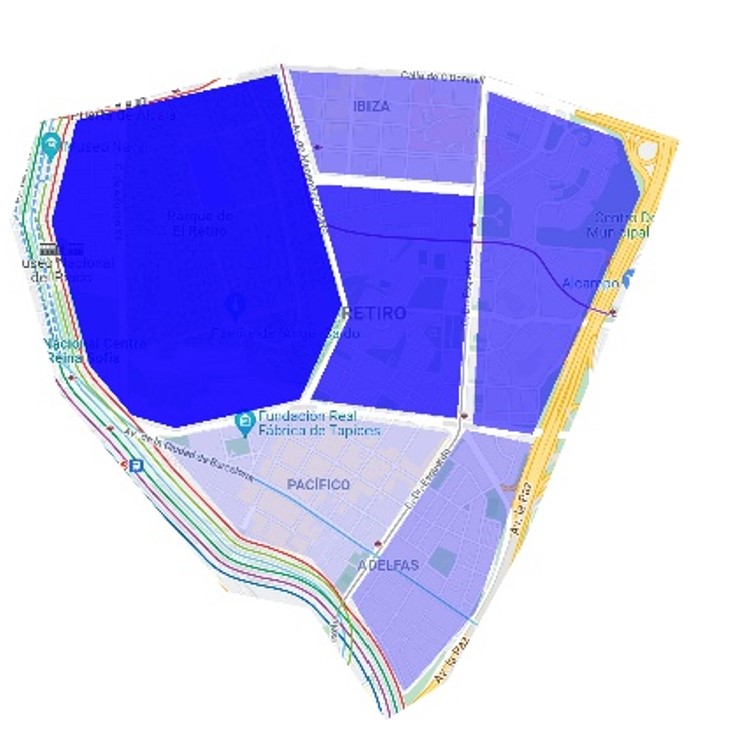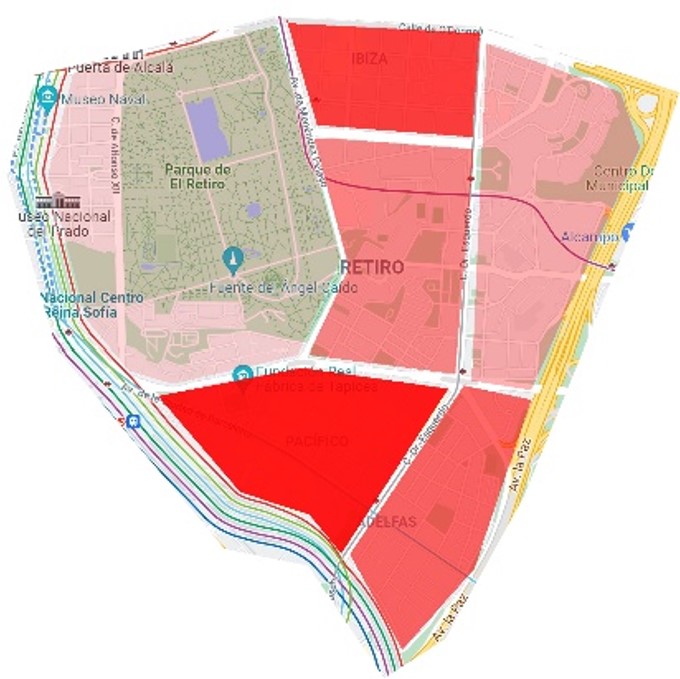
What have others thought, studied and experienced?
Where are we acting from?
What legal resources and pathways do we count with?
What is the expert’s perspective?
Interviews, data, statistics, academic review and Law can help us answer them.
INDEX
Geographical and age scope
Scholars literature
Mental health situation
Public power: regulation and information
Geographical and age scope
This research’s geographical scope is a Madrid’s District called Retiro, composed by 7 smaller areas. It is located inside the so-called Madrid’s Almond, which is delimited by a pathway corridor known as M30. Our age target is though the range comprised by circa 15 to 19 years old under the label of adolescence.
Madrid Retiro is 5,38 Km2, has 120.406 inhabitants and counts with rich facilities of many kinds like good metro line connections (i.e. the giant station of Atocha which connects southern poorer periphery to the center), touristic emblems or one of Madrid’s lungs (i.e. Retiro park). It’s categorisation well could stand by a comfort neighborhood, counting with a high position in GDP per family and a smooth density per km2. However, no specific data is given on correlations between these two latter factors and/or its relationship with mental illness incidence, as limitations on resources and timeade it impossible. In its absence, some observational conclusions on the coincidence between green, richer and less densened areas is seen in the following mappings. Furthermore, there are relevant health facilities like Hospital Niño Jesús which is a pioneer on infant and adolescent psychiatry or two sociocultural centres called Clara Campoamor And Luis Pedró. The latter two, though, do not include relevant programmes on this research’s intentions, being more focused on local political engagement and bibliographical resources.

«This District is one with the highest demand. Ibiza has always been one of the most expensive ones to live in, since its birth. Its biggest issue is its urban street network. It is so gridded that no space for green or dynamic spaces is been left. Some authors have thought on this, like Santiago Cirugeda with his green-roof solution».
Madrid’s Architect.
«We have experienced a gradual change towards more green areas around Hosp. Niño Jesús, to the point that it seems Retiro Park opens its southern border to integrate with the city. This is not possible in the other three fronts due to the giant barrier presented by affluent roadways».
Madrid’s Architect

«We must be cautious when studying this District, there might exist some not-into-account variables like family’s high purchaising power».
Familiar Psychiatric Therapist.


Put in WHO words, Adolescence is a crucial period for developing social and emotional habits important for mental well-being. During this developmental stage, we create our self-identity and emancipate from several previous beliefs to construct our brand new ones (e.g. it might explain the ‘rebel’ conducts against our parents). In this process, social comparison permits to direct your self-conception towards a new scene, which not always is adaptative given the first contacts with drug use and abuse or appearance of insecurities like body image ones. A city pushing adolescents towards isolation risks to inhibit sane constructs and promote detrimental conducts in the belief they help as “catharsis” solution.
Scholars literature
What is it that makes a society happy, thriving and resistant? Several theorists have positioned from diverse perspectives. Positive Psychology defend preventiveness, active participation and human empowerment either at individual, social or institutional levels (Seligman, 2000). Social capital recall us the importance of linking, bonding and bridging connections might be more powerful than physical infrastructures in human development (Aldrich and Meyer, 2015). Community Resilience seeks to prepare societies from chaos after a disastrous event occur (Sherrieb, Norris and Galea, 2009). Having its particularities, these theories share a transversal interventional strategy: the enhancement of social supporting connections (Cassel, 1976; Cohen and Wills, 2000; Wirth, 1971). The idea could be summarised by affirming social connections bring direct emotional, instrumental and material resources to every participating actor, which could prevent from mental distress and indirectly promote pro-civic attitudes like political engagement, empathy, defence of human rights, etc.
«The field of positive psychology at the group level is about the civic virtues and the institutions that move individuals toward better citizenship: responsibility, nurturance, altruism, civility , moderation, tolerance and civic ethic.«
Seligman, 2000.
«Demands after covid-19 first lockdown in Madrid have changed consistently. They ask us more and more for a balcony, being close to a park or outskirt’s new houses instead of studios in the city centre. Overall, professional-client relationship has become much more aseptic, the younger they are, the more they write a WhatsApp message instead of calling«. Madrid’s Architect.
«Society as a whole is affected. Adolescent face frustation more and more. Anxiety, stress and depression are the most common pathological symptons they are facing».
Researcher and University Docent
«The situation is crude, increasing and aggravated by new variables not only because of the stress or sense of impotence produced by covid lockdown, but also by the increase on marital separations, divorces and conflicts that has mounted, which always create sentiments of culpability in adolescents«
Psychiatric Familiar therapist
Mental health situation
Discussions on the existence of an urgent response seem more and more predominant. Before covid-19 pandemic neurotic, stress-related, somatoform, ADHD, eating and conduct disorders increased longitudinally with evident prevalence in females in most of them (J. Carballo, Juan et al., 2012). Prevalences that, far from contracting, have picked up after social distancing measures. WHO recently reported in September depression, anxiety and behavioural disorders are among the leading causes of illness and disability among adolescents. Not only disability but life per se has been endangered, since suicide is the fourth leading cause of death among 15-19 year-olds (WHO, 2021). Social media, intrinsically connected to adolescent’s social life, reveal how they refer more to suicide and anxiety compared to pre-pandemic studies (El país) and particularly among at-risk groups like hyperactive or those with eating disorders (…).
Urban Planning has restated this line of action when designing cities. Oeuvres and ideas like McCay’s and Roe’s Restorative Cities, Oldenburg’s ‘Third Places’ or Newman’s ‘Defensible Space’ move urbanism towards a more dynamic interconnected daily life construction for city’s inhabitants. All of them state that if we want a city aligned with people and not aligning them, we should take citizens themselves at the centre of urban planning. It means hearing them, empowering them and creating spaces for them to develop and connect. Some general patterns has been found in this sense like green spaces, dynamic atmospheres or colourful designs preventing from several mental illnesses METER A MCCAY Y A THE HAPPY CITY . Furthermore, not only are technocratic opinions that tend to criticise dehumanised cities, but artists too. Poets like Lorca in 1926, the contemporary Lionheart or the British animator Steve Cutts inform about the enriching dialogue between art and urbanism, which somehow reflects how cities are nothing but a genuine human creation, and so should behave.
“[Poet in New York] may well be one of the greatest books of poems ever written about New York City. . . . A fierce indictment of the modern world incarnated in city life . . . Wildly imaginative . . . An apocalyptic outcry, a dark, instructive, metaphysical bowl of loneliness.” —The New Yorker On Spanish poet Lorca's work (1929) during his experience in New York.
«Under my point of view, there are areas in Madrid where formal associations are recently a sort of mode, like LGTBQ+ ones in Chueca District»
Madrid’s architect
«Mixed spaces should be the way to attract adolescents. Their engagement depend on what they want and aspire. Interior-exterior profit or short-long term activities could perfectly combine, and the facilities nesting their connections should consider it»
Psychiatric Familiar therapist
Regarding youngsters’ ways of association, there is evidence to assert they interact more informally than formally. There are just a bunch of young age-oriented associations in the District’s dedicated Register, being the most typical described type of association informal meetings in terraces and public spaces. Those have recently faced some struggling outcomes, perhaps due to the lack of shared material objectives or guidance, like the rise in dangerous conducts of drug use and abuse, cyber-bullying or anti-feminist beliefs among adolescents.
Public power: regulation and information
Madrid’s administrative organisms are complexly divided horizontally by areas of action and strung in attributed competences vertically, from the regional executive to district’s social centres like the Regional Office on the Coordination of Mental Health or Madrid Salud Local Organ to name some across the administrative network. Perhaps it is why it seems to exist a certain impenetrability between synergic areas like urban planning, social services and mental health. Furthermore, this lack of frontal cohesion risking passivity in social actions may be one cause of the worsening in mental health distress. Indeed, there are some that stress the pandemic tints of mental health (UNRIC, 2021), and as we have seen, the more decentralised action is, the more ineffective measures are.
However, there exist some new platforms like Madrid Futuro trying to overcome this obstacle of compartmentalisation. It was founded in 2020 after Multi-stakeholder’s website initiative founded by thirty cross sectorial enterprises (i.e. consultancy companies among other), civic associations (e.g. Caritas) and public political actors (Madrid’s Mayor Martinez Almeida). Its creation was pushed by New Generation EU coming Funds, which mounts 8000 million euros. Its main aim is creating a participatory debate space where to decide the city’s socioeconomic Reconstruction after covid crisis. One of its core strategic guidelines covers health and well-being promotion, directed by the local administration’s objectives of digitalisation, public-private collaboration and social cohesion. However, the specific ongoing projects seem far from being intervening the urgent call of adolescents’ recovery after social ties deterioration.
Health system and initiatives are quite palliative-oriented either talking about pre-pandemic or after-pandemic. 100 million euros (13082000000 JPY) spent mainly in reinforcing health professionals workforce and mental health centres or the telephone number assisting on suicide that has recently been created, 024. Thus, the role of Psychology in Madrid appear to be reluctant to Positive Psychology premises, acting after the crisis instead of promoting good practices before the suffering start.
Regarding urban planning, it is quite interested in other priorities like pro-green measures or mobility optimization. Some analysis on why it is like that might be the political fight the current local Almeida’s administration had with the former Carmela’s one in urban decisions like Madrid Central, a pack of restrictions of polluting vehicles in the city centre, the dispute on the speculative rental prices inside M30 pathway cordon or Madrid Norte remodelling urban plan between Chamartín station and Las 4 Torres complex known as Madrid Nuevo Norte.
«Public aids and subsidies always help when pushing the implementation of these social policies. However, they risk to be inefficient as what happened de facto after 2004 Regional Law on Familiar Mediation«.
Psychiatric Familiar therapist
«Public consciousness on the relevance of mental health is a must. For instance, when it comes to suicide visualization»
Researcher and University Docent
«In Madrid’s Urban Planning habitual interest, urban development and economic performance are always a priority. Effective encouraging measures to other interests has been the transparency on to respect certain standards, like the obligation of presentation a Gender Impact for some Urban Plans. Perhaps something similar could serve to integrate mental health prevention in planner’s job»
Madrid’s Architect
On the other hand, both local, regional and national organisms offer a vast amount of data, analysis and useful information like CIS, Transparency organ, National Ministry of Health, the Carlos III Health Institute among others. From them, we can extract physical and social variables that might be interesting to understand social connections among adolescents.


